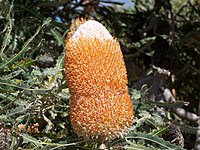
Photo from wikipedia
The conversion of the macroalgae Ulva prolifera into monosaccharides and value-added furfurals in water or water-tetrahydrofuran co-solvent with formic acid was studied. At 160 °C in water, different Brønsted acids (initial… Click to show full abstract
The conversion of the macroalgae Ulva prolifera into monosaccharides and value-added furfurals in water or water-tetrahydrofuran co-solvent with formic acid was studied. At 160 °C in water, different Brønsted acids (initial pH = 2) were tested. The use of formic acid obtained the highest yields of total monosaccharides (Glu 18.8 wt%, Xyl 12.9 wt%, and Rha 42.1 wt%), while lower yields of monosaccharides were obtained with other inorganic acids (HCl, HNO 3 , and H 2 SO 4 ). At 200 °C, the highest yields of furfurals (furfural 7.3 wt%, 5-hydroxymethylfurufural 10.6 wt%, and 5-methylfurfural 17.8 wt%) were obtained in the presence of formic acid in water-tetrahydrofuran-NaCl biphasic system. Formic acid acted as the catalyst for hydrolysis and dehydration, while THF acted as the protector for the formed furfurals in water-tetrahydrofuran-NaCl biphasic system. Furthermore, the increase of reaction temperature or the addition of NaCl promoted the conversion of saccharides into furfurals and the formation of levulinic acid.
Journal Title: Journal of Applied Phycology
Year Published: 2020
Link to full text (if available)
Share on Social Media: Sign Up to like & get
recommendations!